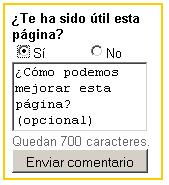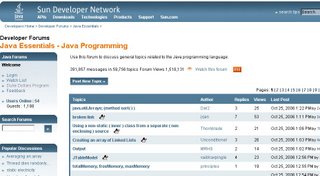Content Management Visitors
Since web 2.0 reach the Internet and updated the traditional philosophy on web application developing and design, a huge number of RIA (Rich Internet Applications) grew up.
With some fixed targets RIA developers focus their efforts on involving users in a rich web-using experience, a usable design and a real interaction.
Static webs pages are dying, users look for interact with sites, and one of the problems designers and developers find in the application develop is which is the best way to let users interact on the site.
When in a user is known the intention of be involved at the site I called him Content Management Visitor, in advance CMV, so they can manage, by some way, the final content of our site.
CMV profile is a medium-low to highly advanced experienced user, with some knowledge on the main topic of the sites he visits. It’s this little knowledge that allows user to get a formed idea on what the site is talking about or at least, it allows him to make his own opinion of what the author says.
If the site is not about specific topic, I mean if site talks about general topics, more users can be potential CMV than in specifics ones.
Why developers and designers need to involve the most the CMV they can? It’s not so difficult to think that interactive users as CMV will add an extra value to our site with their comments and knowledge or opinion so other users can find the additional content richer.
Before web 2.0 and RIA the ways the potential CMV could interact with sites where rudimentary methods, most of them, based on form data submission.
Nowadays these methods have been upgraded to easily ways, and better integration with the site.
Let’s analyze how they were and where are being redesigned to.
Surveys.
One of the most used methods to discover the agreement level of users about the content of our site. Usually focused to general site not to specific parts of it, and integrated in most of the Content Management System.
Who never saw something like this survey?

Nowadays, we can state that this kind of surveys is being disused, although we can find some evoluted poll systems integrated on some of the big ten sites of the Internet.

At Ebay.es it has being redesigned to a feedback styled form. User can, at same time, give his opinion about the utility of the site and suggest some idea to improve it. As heritance of the first type of surveys exposed, still exists some traditional polls improved with the agility of AJAX scripted applications, avoiding refreshing times or submission forms.

Votation
Coming from a kind of survey to one of the common ways so users can interact with sites. Votes were used to give a numeral value to a full site or part of it like in order to represent this number in a graphical chart.


Nowadays votes have been provided with extended functionality that permits structure the web-content depending on the votes it received.
Simple AJAX scripts allow user to state his opinion on an article or a site. Maybe with a numerical value between lowest value to highest one,or just with a binary votation way: yes or no.

Forums
Since communities found at Internet a meeting point, they use Forums as communication way to debate all the topics we can imagine.
Forums create their own page with the amount of content their users publish. Not many things have changed on forum systems.
Their easy usage, common language and drived questions gives users the best way to expose opinions, knowledge or doubts they can have in anything what is being talking about.

Some forums have being improved with some AJAX script in spite of consisting on the same idea.

Guest books and quick chats
Appeared on community sites, guest books and quick chats got a very small functionality on the site content talking.
Used to give a record or just a like or dislike comment about the content of the site guest books are not used nowadays, small text areas, limited texts longitudes and irrelevant content make them useless to handle interesting web content, same is happening on quick chat functions.

Comments
Maybe the comments have been the content modifier which the most entrance rate since web 2.0 arrives.
With the explosion of blogs over the Internet, the comments are being adapted as the best way to interact between author and audience. Just not with the porpouse of debate the author article with in favour or against opinions, users can expand, re-explain or introduce new points of view to the original article.
Really intrusive, but really interesting content can be added to the main article.

Wikis
Introduced by Wikipedia those web encyclopaedias create their own way of content management.
As collaborative websites wikis are now used to host tutorials and all the information we know as knowledge. Many enterprises use wikis to publish their employees knowledge on one area to spread this to another employees around the enterprise.
The anonymous collaboration, and the constant revision by other users make the wikis a perfect way for publish and got quality and reliable content on our site.

Future of Content Management Visitors
Now we know all the methods used nowadays in which users can collaborate with other sites adding Content to them, then its time to evaluate these methods and think about where they should go in future to improve their functionality in the optimum way for visitors and webmasters.
It seems that blogs came to stay for long time, so it’s not so hard to predict that comments ways will be one of the most used Contents Adders Functionalities.
Maybe a comment is normally used to give an opinion about the main content and not to publish more content about the topic of the site.
Another limitation is the administration, a comment can’t be edited, just published or deleted, then it can be formed of wrong content and no other administration can be done than delete the comment and lost this information in spite of being wrong, it can express some bad idea of what people know about the topic.
These limitations make me envision that wikis will be used to publish content and to let visitors add their own content and being administrated and evaluated about other users and the webmasters.
In the way of wikis, maybe in a not so fair future, collaborative office documents as Papers and spreadsheets can be extended to a general functionality as a new publication way for a site
Votation will be the core of the social positioned content on meta-blogs sites and e-commerce positioned products, sellers and buyers.
To specialize in topics, some topic-knowledge people will use these functionalities with collaborative tools to share their knowledge. This association will limit the extra surround that a noob visitor can produce adding content, as he will not have the correct credentials.
Sure that many other ways than these I give will be developed and will get success. The social component gave by a social content addition will be included more and more in all kind of sites.
As you have noticed, at this article I've beeing using Content Management Tools used in top Internet sites as Google, Slashdot, Ebay ... It should make other webmaster what kind of innovation we need at our sites to share our topic with our readers and visitors.
With some fixed targets RIA developers focus their efforts on involving users in a rich web-using experience, a usable design and a real interaction.
Static webs pages are dying, users look for interact with sites, and one of the problems designers and developers find in the application develop is which is the best way to let users interact on the site.
When in a user is known the intention of be involved at the site I called him Content Management Visitor, in advance CMV, so they can manage, by some way, the final content of our site.
CMV profile is a medium-low to highly advanced experienced user, with some knowledge on the main topic of the sites he visits. It’s this little knowledge that allows user to get a formed idea on what the site is talking about or at least, it allows him to make his own opinion of what the author says.
If the site is not about specific topic, I mean if site talks about general topics, more users can be potential CMV than in specifics ones.
Why developers and designers need to involve the most the CMV they can? It’s not so difficult to think that interactive users as CMV will add an extra value to our site with their comments and knowledge or opinion so other users can find the additional content richer.
Before web 2.0 and RIA the ways the potential CMV could interact with sites where rudimentary methods, most of them, based on form data submission.
Nowadays these methods have been upgraded to easily ways, and better integration with the site.
Let’s analyze how they were and where are being redesigned to.
Not Content Modifying Systems
Surveys.
One of the most used methods to discover the agreement level of users about the content of our site. Usually focused to general site not to specific parts of it, and integrated in most of the Content Management System.
Who never saw something like this survey?

Nowadays, we can state that this kind of surveys is being disused, although we can find some evoluted poll systems integrated on some of the big ten sites of the Internet.

At Ebay.es it has being redesigned to a feedback styled form. User can, at same time, give his opinion about the utility of the site and suggest some idea to improve it. As heritance of the first type of surveys exposed, still exists some traditional polls improved with the agility of AJAX scripted applications, avoiding refreshing times or submission forms.

Votation
Coming from a kind of survey to one of the common ways so users can interact with sites. Votes were used to give a numeral value to a full site or part of it like in order to represent this number in a graphical chart.


Nowadays votes have been provided with extended functionality that permits structure the web-content depending on the votes it received.
Simple AJAX scripts allow user to state his opinion on an article or a site. Maybe with a numerical value between lowest value to highest one,or just with a binary votation way: yes or no.

Adding Content Modifiers
Forums
Since communities found at Internet a meeting point, they use Forums as communication way to debate all the topics we can imagine.
Forums create their own page with the amount of content their users publish. Not many things have changed on forum systems.
Their easy usage, common language and drived questions gives users the best way to expose opinions, knowledge or doubts they can have in anything what is being talking about.

Some forums have being improved with some AJAX script in spite of consisting on the same idea.

Guest books and quick chats
Appeared on community sites, guest books and quick chats got a very small functionality on the site content talking.
Used to give a record or just a like or dislike comment about the content of the site guest books are not used nowadays, small text areas, limited texts longitudes and irrelevant content make them useless to handle interesting web content, same is happening on quick chat functions.

Comments
Maybe the comments have been the content modifier which the most entrance rate since web 2.0 arrives.
With the explosion of blogs over the Internet, the comments are being adapted as the best way to interact between author and audience. Just not with the porpouse of debate the author article with in favour or against opinions, users can expand, re-explain or introduce new points of view to the original article.
Really intrusive, but really interesting content can be added to the main article.

Wikis
Introduced by Wikipedia those web encyclopaedias create their own way of content management.
As collaborative websites wikis are now used to host tutorials and all the information we know as knowledge. Many enterprises use wikis to publish their employees knowledge on one area to spread this to another employees around the enterprise.
The anonymous collaboration, and the constant revision by other users make the wikis a perfect way for publish and got quality and reliable content on our site.

Future of Content Management Visitors
Now we know all the methods used nowadays in which users can collaborate with other sites adding Content to them, then its time to evaluate these methods and think about where they should go in future to improve their functionality in the optimum way for visitors and webmasters.
It seems that blogs came to stay for long time, so it’s not so hard to predict that comments ways will be one of the most used Contents Adders Functionalities.
Maybe a comment is normally used to give an opinion about the main content and not to publish more content about the topic of the site.
Another limitation is the administration, a comment can’t be edited, just published or deleted, then it can be formed of wrong content and no other administration can be done than delete the comment and lost this information in spite of being wrong, it can express some bad idea of what people know about the topic.
These limitations make me envision that wikis will be used to publish content and to let visitors add their own content and being administrated and evaluated about other users and the webmasters.
In the way of wikis, maybe in a not so fair future, collaborative office documents as Papers and spreadsheets can be extended to a general functionality as a new publication way for a site
Votation will be the core of the social positioned content on meta-blogs sites and e-commerce positioned products, sellers and buyers.
To specialize in topics, some topic-knowledge people will use these functionalities with collaborative tools to share their knowledge. This association will limit the extra surround that a noob visitor can produce adding content, as he will not have the correct credentials.
Sure that many other ways than these I give will be developed and will get success. The social component gave by a social content addition will be included more and more in all kind of sites.
As you have noticed, at this article I've beeing using Content Management Tools used in top Internet sites as Google, Slashdot, Ebay ... It should make other webmaster what kind of innovation we need at our sites to share our topic with our readers and visitors.

